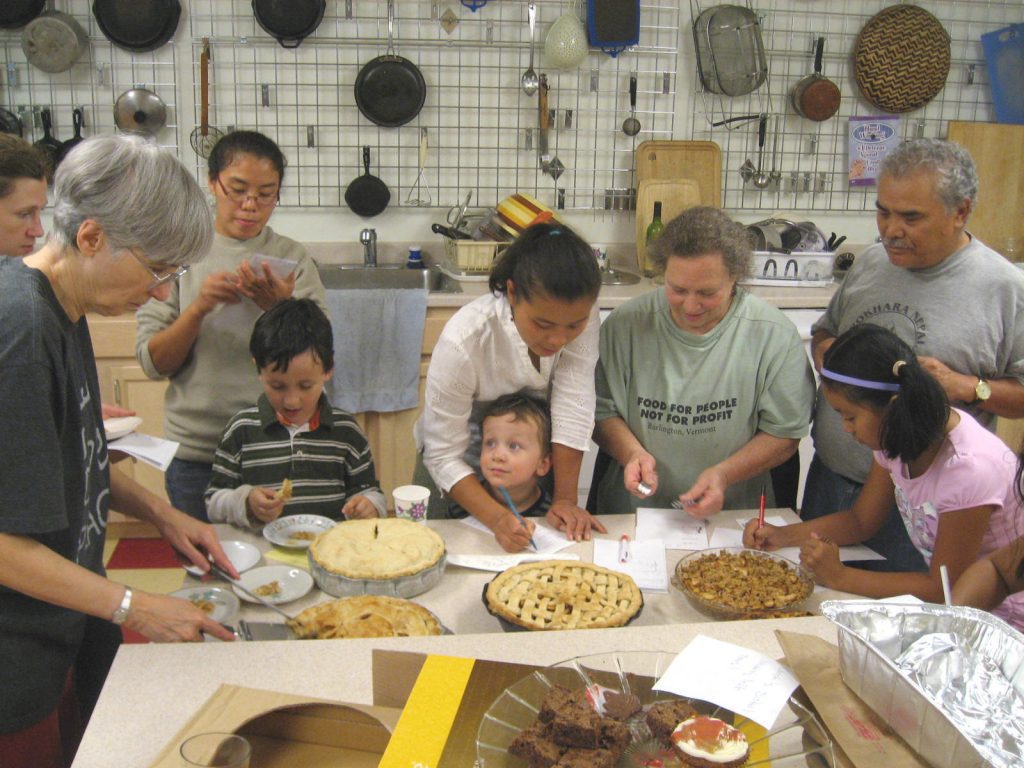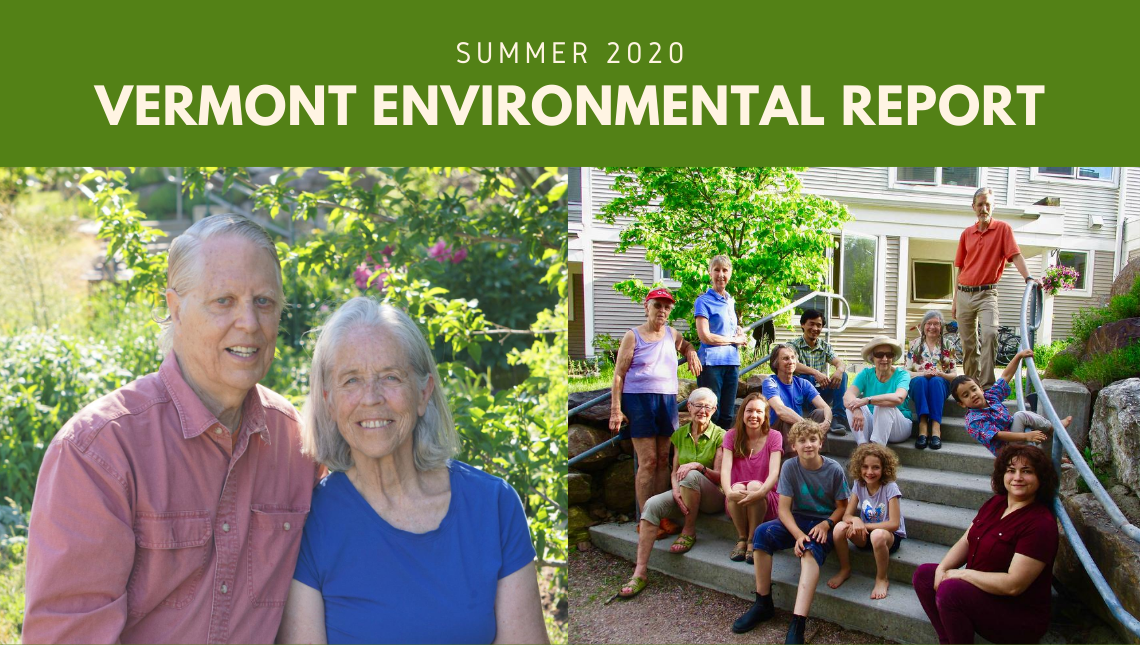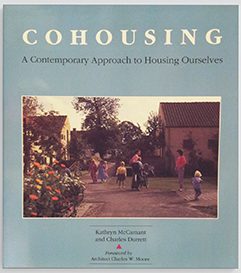Don Schramm is a founder and resident of Burlington Cohousing on East Village Drive in Burlington, Vermont. Don’s lifetime hobby has been co-ops of all sorts – parents’, workers’, housing, and food. Aside from cohousing, he is best known for helping to create City Market/Onion River Co-op. Don answered many of these questions with the help of his cohousing neighbors. Learn more about Burlington Cohousing at www.bcoho.org.
Pictured above, left: Don Schramm and his wife Barbara Nolfi in front of their home (credit: Claire Knight) and right: Residents at Burlington Cohousing (credit: Angela Munno).
This article also appears in the Summer 2020 issue of the Vermont Environmental Report. Read it here.

Why are you a member of the Vermont Natural Resources Council?
I love that VNRC works from visioning where we want our state to be in the future and keeping that vision close while working on individual problems. VNRC tackles the complexities of enhancing our natural environments while remaining cognizant of the human activities making demands upon it, and the role of community in fostering our interactions with the natural world. What VNRC does at the state level, our cohousing community is trying to do at our neighborhood level.
You helped found Burlington Cohousing in 2002, after thinking about that kind of arrangement for decades. What first attracted you to the idea of cooperative housing?
I grew up with two brothers and two sisters and counted on them to support and guide me. Then I worked as a teacher in East Africa for three years and spent some time living in traditional compounds there, where multi-generational families lived around shared amenities and a communal gathering place. That’s when I saw how much easier and more meaningful it can be living collaboratively with other people.
In 1988 a friend introduced me to a book called Cohousing: A Contemporary Approach to Housing Ourselves, and a year later we organized a meeting of 70 people who had read the book. The idea to build something in Vermont originated there, but it wasn’t until 2007, after various financial and location hurdles, that we were finally able to realize the idea in Burlington. My neighbors say that they were involved in various kinds of communities: churches, artists’ groups, communes, and large families. They, as I did, wanted community to become the main focus of their lives.
Tell me about some of the ways Burlington Cohousing has reduced its environmental footprint.
Our community was designed with sustainability in mind and our residents are environmentally conscious in their daily activities. On our five acres of property, we have consolidated 32 residential units into six buildings. Individual units are modest in square footage, reducing residents’ energy use. We have passive solar, extra wall and window insulation, a shared laundry facility, and a common heating and hot water system.
Because of our central location in Burlington, our residents often choose to walk, bike, or take public transportation in lieu of driving. When we do drive, we often share cars and have two level-2 electric car charging stations to accommodate hybrid and electric vehicles.
Our conservation efforts are a work in progress, and we are always looking to do more. Still, we are discouraged by the immense amount of CO2 emissions generated by the F-35 planes in Vermont. We have reason to believe that an entire year of CO2 emissions reductions (more than 80 tons) at Burlington Cohousing is wiped out by a single F-35 flight.
What has it been like to weather a pandemic in cohousing? What has it taught you about mutual aid?
If you have to live during a pandemic, cohousing with some green space is the place to be. We were “locked down” early and yet were able to socialize in our larger common spaces indoors and outdoors in gardens and yards — all with proper social distancing. However, we still suffer from not being able to easily see and communicate with our cohousing neighbors.
Mutual aid has been a part of our community from the onset. Nine of our units are perpetually affordable through the Champlain Housing Trust, and we are trying to raise money to convert seven additional units to this level of affordability. We shop for each other; we share cars; we check in on neighbors who are sick or in the hospital. Extra vegetables from our gardens go to the local food shelf. For several years we have made dinners for a homeless shelter in downtown Burlington.
The pandemic has taught us who our “essential workers” are and how important they are all the time, not just in this moment of distress. We have also learned that we can ask for help from outside, as well as offering it. For example, some of my neighbors receive aid from Age Well, a Vermont organization that sends volunteers to pick up groceries for older Vermonters, among other services.

People might know you because you ran for State Treasurer multiple times. What was your biggest motivator for seeking that office?
There were two main things that drove me to run for State Treasurer: Educating citizens and building pressure for the State to divest from all fossil fuel stocks and create a State Bank. I believe these are still good ideas for Vermont.
Currently, almost all of the State’s money is invested outside our state. A State Bank would provide a means for us to significantly invest in ourselves: in childcare services, food cooperatives, solar and wind companies, and bringing fiber-optic connectivity to every home in Vermont. Especially now, the ability to work and learn at home demands excellent internet service throughout the state. There are so many ways we could invest in ourselves if given the opportunity.
What else is in your “vision” for Vermont?
I would like to see cohousing communities everywhere. Let’s start with existing condominiums. Folks could get out, meet their neighbors, and envision together how they could make their condo association better for all. I think we all need to find ways of helping each other out, exploring ways to spend time together, and building community. It’s good for all of us all the time, not just in a pandemic.






